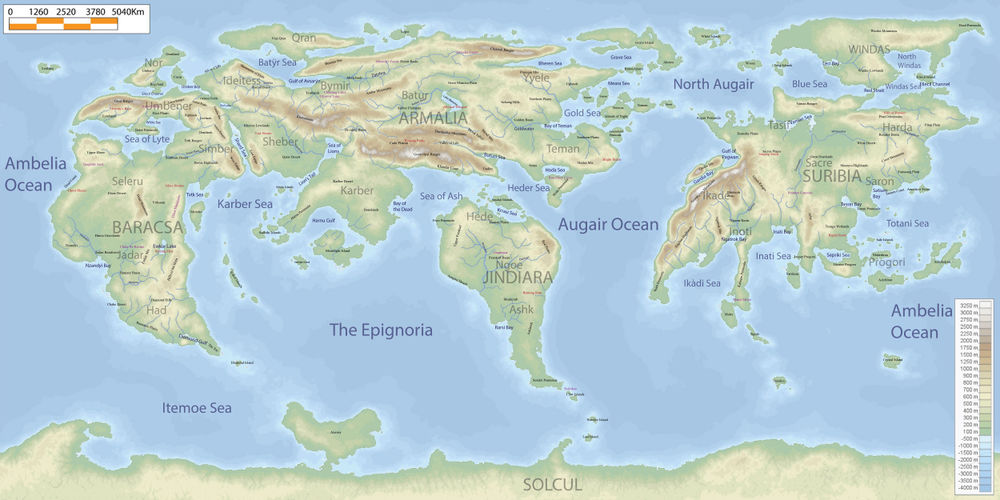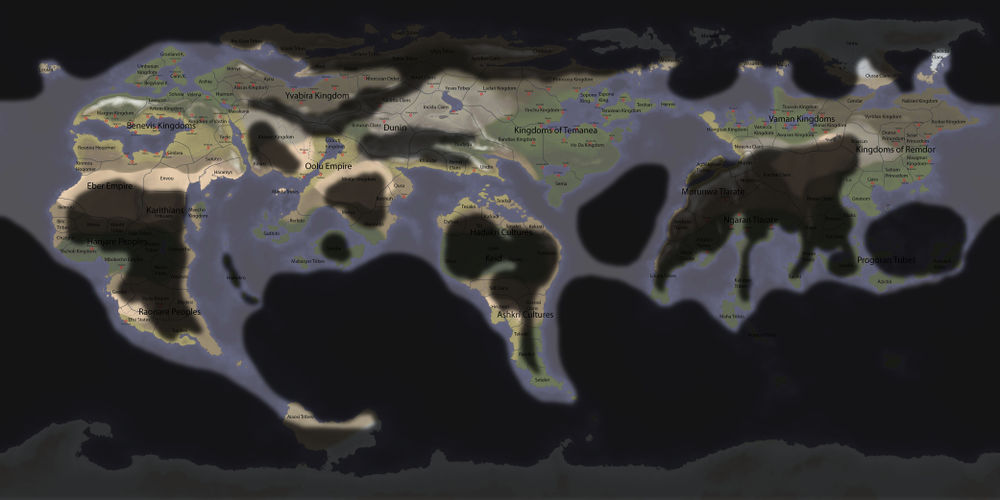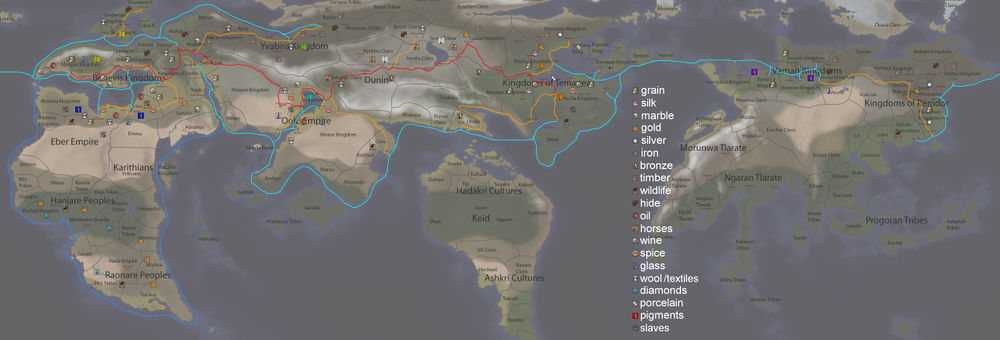World Maps: Difference between revisions
From Riiga
Jump to navigationJump to search
No edit summary |
No edit summary |
||
| Line 1: | Line 1: | ||
==Realistic Biomes== | ==Realistic Biomes== | ||
* Polar/Ice | * '''Polar/Ice''' - Freezing cold land covered primarily in packed ice which sees little sunlight. | ||
* '''Tundra''' - A cold, barren land with frozen soil, almost no trees, and short growing seasons allowing only grasses, shrubs, and mosses. | |||
* Tundra | * '''Taiga''' - Cold forests mostly containing evergreen conifers, with very short summers and cold, snowy winters. | ||
* '''Alpine Tundra''' - A high-altitude, treeless, freezing area with thin air which may be covered in snow throughout the whole year. | |||
* Taiga | * '''Montane Forest''' - High-elevation deciduous forest lands that may be cool or warm depending on their place in the world. | ||
* '''Temperate Forest''' - Forests mostly made of deciduous trees that see distinct warm summers and cool winters. | |||
* Alpine Tundra | * '''Temperate Grassland''' - Grassland which sees freezing winters and hot summers, tough grasses, and low rainfall. | ||
* '''Savanna''' - Grassland which experiences heavy rainfall in one season, but is otherwise quite dry and warm. | |||
* Montane Forest | * '''Wooded Savanna''' - Savanna filled with low-density trees that do not create a canopy. | ||
* '''Subtropical Forest''' - Forest that sees high precipitation, warm weather, and humidity, with a distinct canopy. | |||
* Temperate Forest | * '''Monsoonal Forest''' - Deciduous forest that experiences a long dry season followed by a season of extreme rainfall. | ||
* '''Subtropical Rainforest''' - Tall forests that see regular rainfall but experience a short dry season, with a multi-layered canopy and rich soils. | |||
* Temperate Grassland | * '''Tropical Rainforest''' - Tall, lush rainforests that see heavy continuous rainfal and no dry season, with several distinct canopies and poor soil quality. | ||
* '''Mediterranean''' - Land with cool and wet winters and dry summers, with most rainfall falling during winter and a lot of sunlight. | |||
* Savanna | * '''Dry Grassland''' - Cool grassy lands with low-growing vegetation and patchy coverage, perfect for grazing animals. | ||
* '''Semiarid Desert''' - A desert with less sand dunes and more barren rocky ground that sees a wide range of temperatures. | |||
* Wooded Savanna | * '''Arid Shrubland''' - Land with very little rainfall covered mostly in sparse shrubs and stones rather than sand dunes. | ||
* '''Arid Desert''' - A very cold or very hot barren, dusty land with almost no precipitation, hostile toward most flora and fauna. | |||
* Subtropical Forest | |||
* Monsoonal Forest | |||
* Subtropical Rainforest | |||
* Tropical Rainforest | |||
* Mediterranean | |||
* Dry Grassland | |||
* Semiarid Desert | |||
* Arid Shrubland | |||
* Arid Desert | |||
[[File:geogriiga1.jpg|1000px|thumb|A geographic map of Riiga showing biome distribution. Natural phenomena are marked in red and natural wonders are marked in purple.]] | [[File:geogriiga1.jpg|1000px|thumb|A geographic map of Riiga showing biome distribution. Natural phenomena are marked in red and natural wonders are marked in purple.]] | ||
Revision as of 10:45, 14 February 2020
Realistic Biomes
- Polar/Ice - Freezing cold land covered primarily in packed ice which sees little sunlight.
- Tundra - A cold, barren land with frozen soil, almost no trees, and short growing seasons allowing only grasses, shrubs, and mosses.
- Taiga - Cold forests mostly containing evergreen conifers, with very short summers and cold, snowy winters.
- Alpine Tundra - A high-altitude, treeless, freezing area with thin air which may be covered in snow throughout the whole year.
- Montane Forest - High-elevation deciduous forest lands that may be cool or warm depending on their place in the world.
- Temperate Forest - Forests mostly made of deciduous trees that see distinct warm summers and cool winters.
- Temperate Grassland - Grassland which sees freezing winters and hot summers, tough grasses, and low rainfall.
- Savanna - Grassland which experiences heavy rainfall in one season, but is otherwise quite dry and warm.
- Wooded Savanna - Savanna filled with low-density trees that do not create a canopy.
- Subtropical Forest - Forest that sees high precipitation, warm weather, and humidity, with a distinct canopy.
- Monsoonal Forest - Deciduous forest that experiences a long dry season followed by a season of extreme rainfall.
- Subtropical Rainforest - Tall forests that see regular rainfall but experience a short dry season, with a multi-layered canopy and rich soils.
- Tropical Rainforest - Tall, lush rainforests that see heavy continuous rainfal and no dry season, with several distinct canopies and poor soil quality.
- Mediterranean - Land with cool and wet winters and dry summers, with most rainfall falling during winter and a lot of sunlight.
- Dry Grassland - Cool grassy lands with low-growing vegetation and patchy coverage, perfect for grazing animals.
- Semiarid Desert - A desert with less sand dunes and more barren rocky ground that sees a wide range of temperatures.
- Arid Shrubland - Land with very little rainfall covered mostly in sparse shrubs and stones rather than sand dunes.
- Arid Desert - A very cold or very hot barren, dusty land with almost no precipitation, hostile toward most flora and fauna.
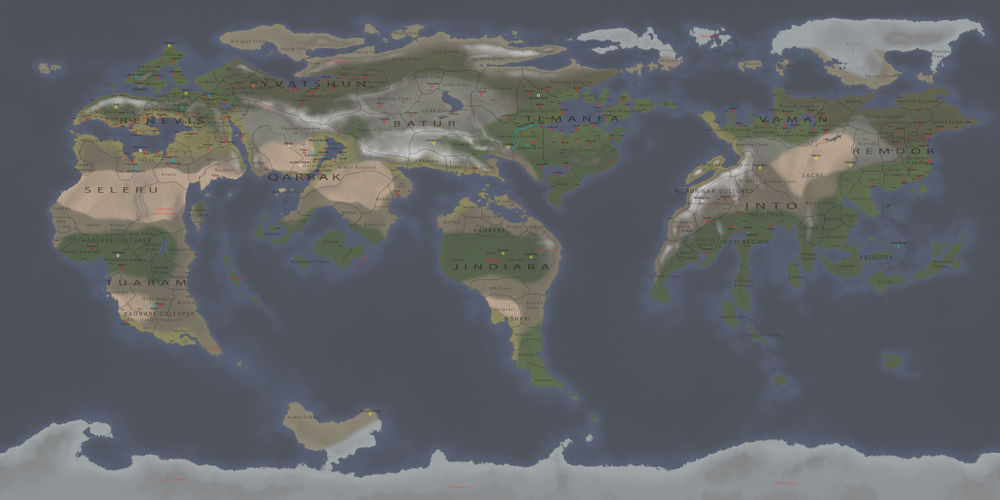
A political map showing empires, kingdoms, states, tribal groups, and clans, as well as the largest cities of Riiga. Each city marked represents a population of 10,000,000 both within it and in the surrounding area. It also shows known Archaios locations, and man-made Wonders of certain (blue) or uncertain (white) locations.
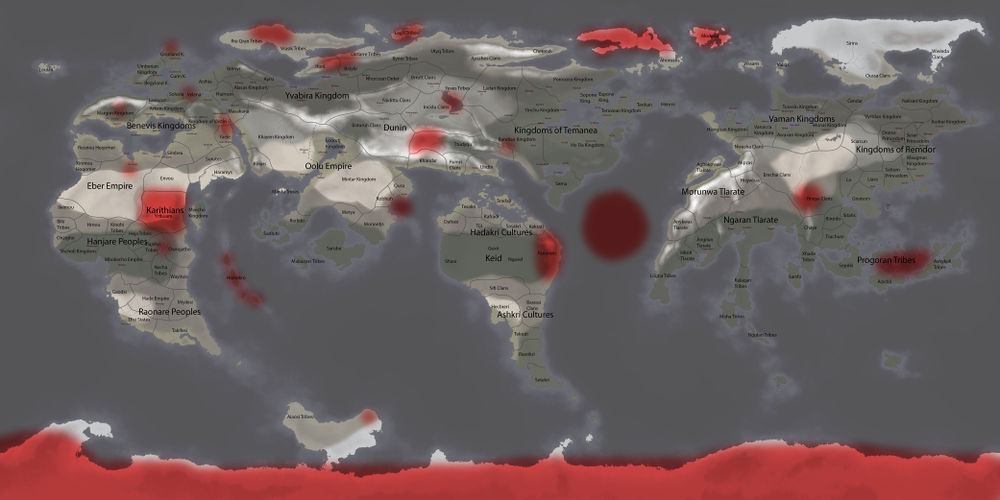
A map of current and historical sites of heavy monster or monster-race activity.
